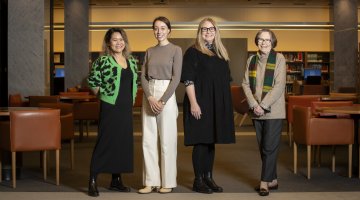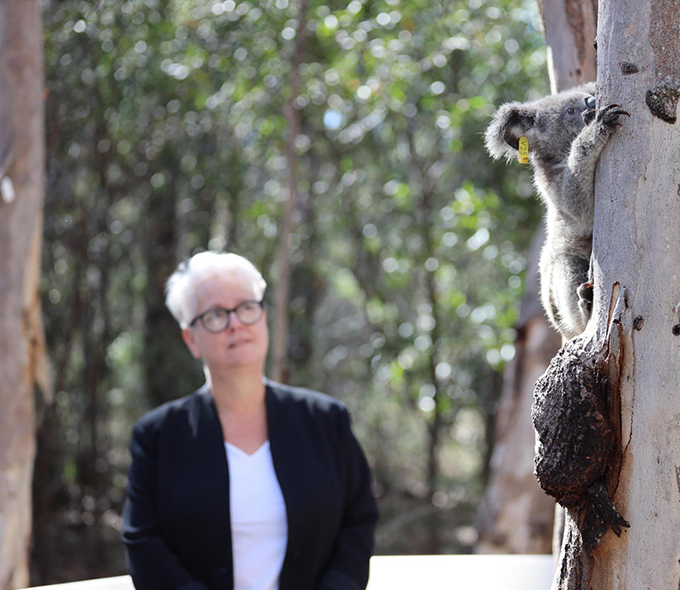 Professor Tobias Kretzschmar inspects a test plot of coffee cultivars
Professor Tobias Kretzschmar inspects a test plot of coffee cultivars Leathery latte, anyone? Petroleum piccolo? How about a skunky short black, a cardboard cappuccino or a mouldy macchiato?
As the saying goes, there’s no accounting for taste, but surely these flavours would not find too much favour in your local cafe.
And yet they are actual descriptions used by Southern Cross University researchers to compile a universal coffee vocabulary, one of several projects underway to improve and expand Australia’s coffee industry.
About one per cent of the coffee we drink in Australia is grown here, despite several zones with suitable climates and a devoted population of coffee drinkers.
With 99 per cent of total coffee consumption from imported beans, mostly from South America, Australia’s caffeine love affair racks up some serious food miles, a significant driver of climate change.
Southern Cross researchers are on a mission to change that, and to shrink the journey from plant to cup, while supporting the development of a sustainable, commercially viable industry.
In one project funded by AgriFutures Australia, Dr Ben Liu is matching the different tastes of coffee to 50,000 chemical markers.
Does coffee have a terroir?
“The aim is to identify and describe the unique sensory attributes of Australian coffee, particularly in relation to terroir, and how these findings relate to the palates of coffee consumers,” said Dr Liu.
Terroir refers to the environmental, varietal and agricultural factors that inform sensory experience. The term is well known in the wine industry and is becoming increasingly important for coffee.
In June 2022, Dr Liu and colleagues from Southern Cross University’s Faculty of Science and Engineering co-authored a paper on the subject, also developing a colourful sensory character wheel with some surprising mouthfeel and acidity descriptors for coffee like gritty, silky, winey and vinegary.
Investing in coffee’s growth potential
Professor Tobias Kretzschmar said that while coffee is a niche industry in Australia, expansion is being held back by current practice and lack of varietal choice.
“The subtropical Australian coffee industry is based on one imported cultivar, namely the K7 variety of Coffea arabica, which needs constant pruning and this increases labour costs and affects production,” he said.
“While coffee production in Australia is currently restricted to Northern NSW and southern Queensland coastal areas and the Atherton table lands, new cultivars, especially if they exhibit some degree of frost tolerance, could expand the range significantly, increasing the industry footprint.”
The good news is that AgriFutures Australia has identified and invested in the growth potential of the Australian coffee industry.
This includes a partnership with Southern Cross University and the Australian Subtropical Coffee Association to secure access to new coffee cultivars. The University has also partnered with World Coffee Research, which has provided 25 coffee accessions from 10 countries. These are currently being trialled at the University’s coffee site near the Lismore campus in the subtropical northern NSW region and in the tropical highlands of the Atherton tablelands.
“To attract investment, keep production costs competitive, encourage new growers and in turn grow the industry, Australian growers need access to new cultivars that are suitable to local conditions and which maintain or even improve the quality and flavour of the coffee in your cup. I believe we can do that in a way that is sustainable,” said Professor Kretzschmar.
The variety they’re using at the moment is very tall and very leggy when they decided on it about 20 years back it was the most productive and high quality variety but unfortunately it just never stopped growing so what the industry is looking for is a new variety that will say at a state a semi-dwarf state of around two metres which allows continuous machine harvesting without having to prune regularly.
What we’re trying to achieve is to find a variety that’s better suited than what’s typically grown in this region. We’re getting funded from Agrifutures from the Emerging Industries portfolio so their goal would be to have coffee 10 million gross value every year in five years, that can only be achieved if we do find a new variety that can replace the old variety.
We’re trying to produce a good coffee cherry with the good beans in there.
From the coffee cherry to a cup of coffee there are still lots of processing that needs to be done and for example there’s different post-harvest processing and maybe it requires different drying, different fermentation process. We also want to find the scientific evidence behind a good cup of coffee. There may be a different variety of coffee can be grown in Australia and each variety could actually have a different flavour characteristic. For example some coffee is very sour, some coffee may be very fruity. What we are doing here is trying to standardise the terminology to describe a cup of coffee. So we can find 50,000 different chemical markers in a cup of coffee and what we’re trying to do is trying to link this sensory data that comes from coffee tasting panels to these 50,000 chemical markers and so later we can actually reproduce the same cup of coffee with the same flavour. As we can produce a good glass of wine in Australia I believe we can also produce a good cup of coffee.
Transformative ‘harvest to health’ innovation at Southern Cross University
Agriculture and plant science at Southern Cross University are ranked in the highest tier of ‘well above world standard’ in the Excellence in Research for Australia report by the Australian Research Council.
Last year saw the launch of a new cluster of research capability, ‘Harvest to Health’, bringing together the University’s significant strengths in functional foods and natural products, a formidable concentration of research muscle to develop better foods, medicines and outcomes for human health and industry.
Some of the recent, ground-breaking work at the University has included genomic sequencing of the world’s macadamia species, identifying the gene responsible for aroma in fragrant rice and breeding better commercial varieties of high-value crops like tea tree, black rice and hemp.








